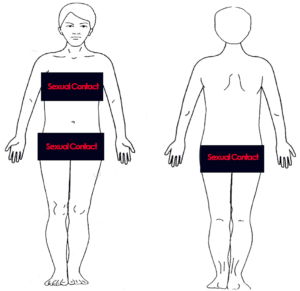
Generally, under Texas law, “Sexual Contact” is any touching of the anus, breast, or any part of the genitals of another person with intent to arouse or gratify the sexual desire of any person.
This is different from “Sexual intercourse” or “Deviant sexual intercourse.” Intercourse means any penetration of the female sex organ by the male sex organ. Deviate sexual intercourse means either: (A) any contact between any part of the genitals of one person and the mouth or anus of another person; or (B) the penetration of the genitals or the anus of another person with an object.
Indecency with a Child applies a more broader definition. In the context of Indecency charges, “sexual contact” means a person acts with “the intent to arouse or gratify the sexual desire of any person” and the person:
- Touches “including touching through clothing” the anus, breast, or any part of the genitals of a child; or
- Touches any part of the body of a child, including touching through clothing, with the anus, breast, or any part of the genitals of a person.
Why does my charge information say “Fondling”?
The former TEX. PENAL CODE, Art. 535d, § 1 defined sexual contact to include “intentionally place or attempt to place his or her hands or any part of his hand or hands upon the breast of a female under the age of fourteen (14) years, or to in any way or manner fondle or attempt to fondle the breast of a female under the age of fourteen (14) years.” In 1974, when the modern Penal Code became effective, the crime was codified as “Indecency with a Child” and the definitions were changed. Many computer systems and forms throughout Texas still have the old language using the word “fondling.”
Breast Touch
The older versions of the statutes punished the touching of a breast only when the breast belonged to a female. The 1974 changes included a definition of “sexual contact.” The 1974 definition of “sexual contact” retained the limitation that the breast must belong to a female and added a minimum age requirement, “ ‘Sexual contact’ means any touching of … the breast of a female 10 years or older with intent to arouse or gratify the sexual desire of any person.”
In 1979 the restrictions on age and gender were removed, so that the text read: “ ‘Sexual contact’ means any touching of the … breast … of another person with intent to arouse or gratify the sexual desire of any person.” The modern definition of “sexual contact” applicable to the indecency offense contains no references to age or gender. Even assuming ambiguity about whether the word “breast” refers to a body part belonging to a female or to a female at a certain age of development, the legislative history resolves that question. Under the current statutory scheme, a “breast” does not have to belong to a female or be developed.
Evidence of Intent to Gratify
For an Indecency charge, the State is required to establish that the sexual contact was committed with the intent to arouse and gratify sexual desire. To prove this, a person does not have to make a statement about their intent. Intent can be inferred from acts, words, and conduct of the accused. Evidence is not limited to the specific act a person is charged with. The prosecution may sometimes offer other circumstantial evidence about how a person acted before and after the alleged crime. In some cases this evidence has included: the accused watched the victim shower; the accused threatened to bribe the victim to not tell anyone about the contact; or (in some cases) the accused had inappropriately touched other minors.
Generally, evidence of a past crime, wrong, or other act is not admissible to prove a person’s character in order to show that in the instant case the person acted in accordance with that bad character. (Texas Rule of Evidence 404). However, this evidence may be admissible for other purposes such as proving motive, opportunity, intent, preparation, plan, knowledge, identity, absence of mistake, or lack of accident. Also, these rules are very relaxed in the context of child sexual abuse cases. Ignoring Rules 404 and 405, Texas Rules of Evidence, the State may offer evidence of other crimes, wrongs, or acts committed by the accused against a child who is the victim of the alleged offense if the State offers the evidence to show:
- the state of mind of the accused and the child; and
- the previous and subsequent relationship between the accused and the child.
Evidence of past child sexual abuse may be used at trial to prove the bad character of the accused and that the current charge was committed “in conformity with the character” of the accused. (Texas Code of Criminal Procedure Article 38.37).

